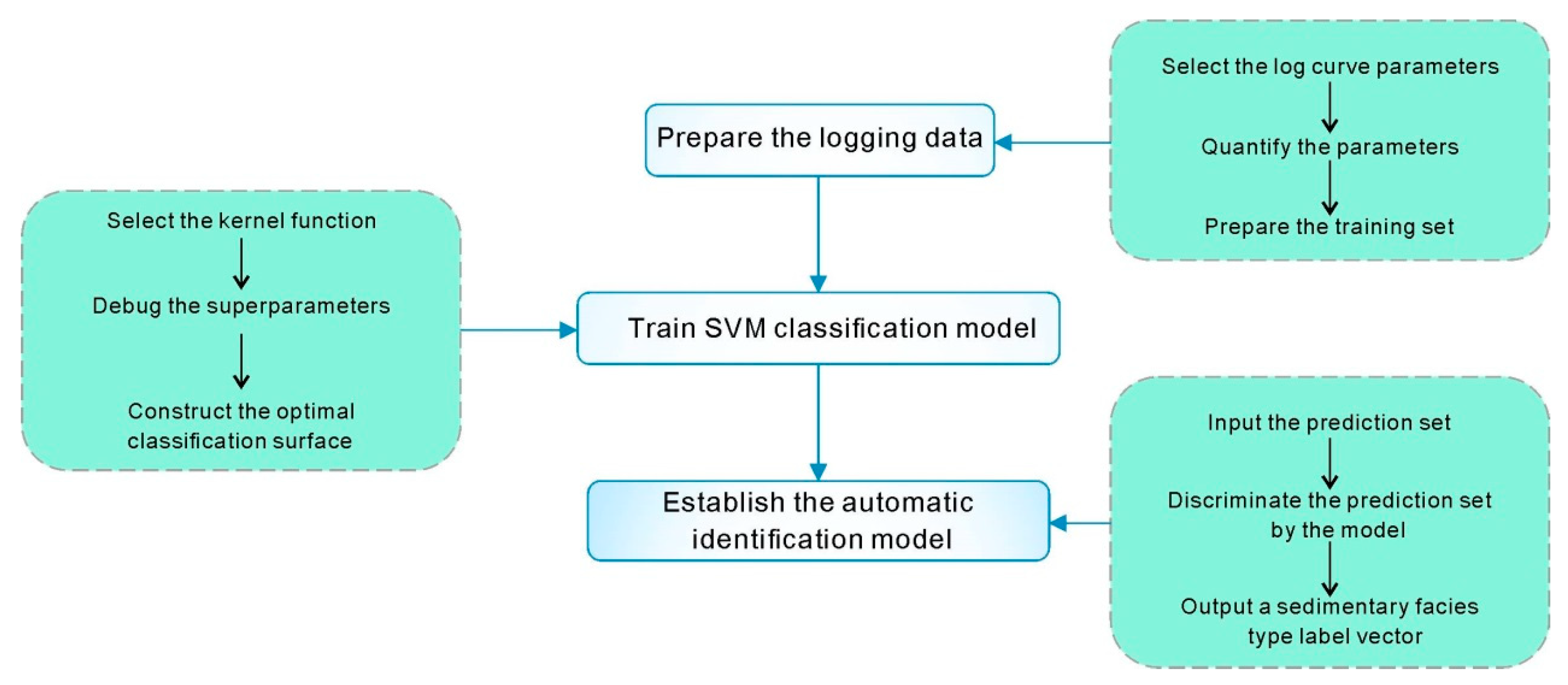Automatic Identification of Sedimentary Facies Based on a Support Vector Machine in the Aryskum Graben, Kazakhstan
Abstract
1. Introduction
2. Geological Setting
2.1. Regional Geological Conditions
2.2. Character of Strata Development
3. Methodology
3.1. Prepare the Logging Data
3.2. SVM Classification Model
3.2.1. SVM
3.2.2. Kernel Function
3.2.3. Optimal Classification Surface
4. Results and Discussion
4.1. Results
4.2. Discussion
5. Conclusions
Author Contributions
Funding
Acknowledgments
Conflicts of Interest
References
- Li, Y.H.; Wang, H.T.; Wang, M.C.; Lian, P.Q.; Duan, T.Z.; Ji, B.Y. Automatic identification of carbonate sedimentary facies based on PCA and KNN using logs. Well Logging Technol. 2017, 41, 57–63. [Google Scholar]
- Lakzaie, A.; Ghasemalaskari, M.K.; Vaziri, M. Reservoir Facies Modeling Using Intelligent Data Gathering in an Iranian Carbonate Field; SPE 121247; Society of Petroleum Engineers: Richardson, TX, USA, 2009; pp. 1–4. [Google Scholar]
- Li, W.B.; Yu, Y.L.; Wang, J.Q.; Bai, Y.; Wang, X. Application of Self-Organizing Neural Network Method in Logging Sedimentary Microfacies Identification. In Advanced Materials Research; Trans Tech Publications: Zurich, Switzerland, 2013; pp. 38–42. [Google Scholar]
- Zhang, F.; Li, H. Application of artificial neural network pattern recognition technology to the study of well-logging sedimentology. Pet. Explor. Dev. 2003, 30, 121–123. [Google Scholar]
- Zhang, J.; Liu, S.; Li, J.; Liu, L.; Liu, H.; Sun, Z. Identification of sedimentary facies with well logs: An indirect approach with multinomial logistic regression and artificial neural network. Arab. J. Geosci. 2017, 10, 1–9. [Google Scholar] [CrossRef]
- Wang, Y.X.; Tian, C.B.; Gao, J.X.; Zhang, X.F.; Liu, J.Q.; Tian, Z.P.; Song, X.M.; Liu, B. A Quantitative Explanation of Carbonate Microfacies Based on Conventional Logging Data: A Case Study of The Mishrif Formation in North Rumaila Oil Field of Iraq. Acta Pet. Sin. 2013, 34, 1088–1099. [Google Scholar]
- Zhang, H.X.; Ma, Z.P.; Ge, P. The Application of the Fuzzy Clustering in Analysis of Well Logging Facies. J. Xian Univ. Arts Sci. Nat. Sci. Ed. 2008, 11, 63–65. [Google Scholar]
- Aghchelou, M.; Nabi-bidhendi, M.; Shahvar, M.B. Lithofacies Estimation by Multi-Resolution Graph-Based Clustering of Petrophysical Well Logs: Case Study of South Pars Gas Field of Iran; SPE 162991; Society of Petroleum Engineers: Richardson, TX, USA, 2012; pp. 1–5. [Google Scholar]
- Zhao, Z.J.; Liu, Y.; Wang, F.Q.; Zhang, Z.G.; Ren, P.H. Classification of Borehole Braided River Sedimentary Microfacies Based on Support Vector Machine. Well Logging Technol. 2016, 40, 637–642. [Google Scholar]
- Bolandi, V.; Kadkhodaie, A.; Farzi, R. Analyzing organic richness of source rocks from well log data by using SVM and ANN classifiers: A case study from the Kazhdumi formation, the Persian Gulf basin, offshore Iran. J. Pet. Sci. Eng. 2017, 151, 224–234. [Google Scholar] [CrossRef]
- Wang, D.H.; Peng, J.; Yu, Q.; Chen, Y.Y.; Yu, H.H. Support Vector Machine Algorithm for Automatically Identifying Depositional Microfacies Using Well Logs. Sustainability 2019, 11, 1919. [Google Scholar] [CrossRef]
- Atluri, G.; Karpatne, A.; Kumar, V. Spatio-temporal data mining: A survey of problems and methods. ACM Comput. Surv. 2018, 51, 83. [Google Scholar] [CrossRef]
- Jordan, M.I.; Mitchell, T.M. Machine learning: Trends, perspectives, and prospects. Science 2015, 349, 255–260. [Google Scholar] [CrossRef]
- Van Gerven, M.; Bohte, S. Artificial Neural Networks as Models of Neural Information Processing; Frontiers Media SA: Lausanne, Switzerland, 2018. [Google Scholar]
- Berry, D.A.; Stangl, D. Bayesian Biostatistics; CRC Press: Boca Raton, FL, USA, 2018. [Google Scholar]
- Chaghari, A.; Feizi-Derakhshi, M.; Balafar, M. Fuzzy clustering based on Forest optimization algorithm. J. King Saud Univ. Comput. Inf. Sci. 2018, 30, 25–32. [Google Scholar] [CrossRef]
- Vapnik, V. The Nature of Statistical Learning Theory; Springer Science & Business Media: Berlin, Germany, 2013. [Google Scholar]
- Krebel, U. Pairwise classification and support vector machines. In Advances in Kernel Methods: Support Vector Learning; MIT Press: Cambridge, MA, USA, 1999; pp. 255–268. [Google Scholar]
- Thanh Noi, P.; Kappas, M. Comparison of random forest, k-nearest neighbor, and support vector machine classifiers for land cover classification using Sentinel-2 imagery. Sensors 2018, 18, 18. [Google Scholar] [CrossRef] [PubMed]
- Gharagheizi, F.; Mohammadi, A.H.; Arabloo, M.; Shokrollahi, A. Prediction of sand production onset in petroleum reservoirs using a reliable classification approach. Petroleum 2017, 3, 280–285. [Google Scholar] [CrossRef]
- Palaniswami, M.; Shilton, A.; Ralph, D.; Owen, B.D. Machine learning using support vector machines. In Proceedings of the International Conference on Artificial Intelligence in Science and Technology, Hobart, Australia, 9–12 February 2000. [Google Scholar]
- Buslov, M.M. Tectonics and geodynamics of the Central Asian Foldbelt: The role of Late Paleozoic large-amplitude strike-slip faults. Russ. Geol. Geophys. 2011, 52, 52–71. [Google Scholar] [CrossRef]
- Moseley, B.A.; Tsimmer, V.A. Evolution and hydrocarbon habitat of the South Turgay Basin, Kazakhstan. Pet. Geosci. 2000, 6, 125–136. [Google Scholar] [CrossRef]
- Yin, W.; Fan, Z.F.; Zheng, J.Z.; Yin, J.Q.; Zhang, M.J.; Sheng, X.F.; Guo, J.J.; Li, Q.Y.; Lin, Y.P. Characteristics of strike-slip inversion structures of the Karatau fault and their petroleum geological significances in the South Turkey Basin, Kazakhstan. Pet. Sci. 2012, 9, 444–454. [Google Scholar] [CrossRef]
- Shi, J.Y.; Fan, T.L.; Zhou, J.; Yu, D.F.; Ai, X. Several Typical Seismic Facies in South Turgay Basin and the Geological Meaning. Sci. Technol. Eng. 2015, 15, 133–138. [Google Scholar]
- Zhou, J. The Sequence Stratigraphic and Sedimentary Evolution of Lower Jurassic—Lower Cretaceous in South Turgay Basin, Kazakhstan. Master’s Thesis, China University of Geosciences, Beijing, China, 2014. [Google Scholar]
- Chang, C.C.; Lin, C.J. LIBSVM: A library for support vector machines. ACM Trans. Intell. Syst. Technol. 2011, 2, 27. [Google Scholar] [CrossRef]
- Burges, C.J.C. A tutorial on support vector machines for pattern recognition. Data Min. Knowl. Discov. 1998, 2, 121–167. [Google Scholar] [CrossRef]
- Liu, H.Q.; Chen, P.; Xia, H.Q. Automatic identification of sedimentary microfacies with log data and its application. Well Logging Technol. 2006, 30, 233–236. [Google Scholar]
- Cao, G.H.; Hu, Y.H.; Zhang, Q.W. Study on the Method of Identification of Sedimentary Microfacies Using Well Logging Data. Sci. Technol. Eng. 2007, 7, 3674–3680. [Google Scholar]
- Ma, S.Z.; Huang, X.O.; Zhang, T.B. Mathematic method for quantitative automatic identification of logging microfacies. Oil Geophys. Prospect. 2000, 35, 582–616. [Google Scholar]
- Ding, S.F.; Qi, B.J.; Tan, H.Y. An Overview on Theory and Algorithm of Support Vector Machines. J. Univ. Electron. Sci. Technol. Chin. 2011, 40, 2–10. [Google Scholar]
- Guo, J.X.; Chen, M. Automatic Identification of Sedimentary Microfacies on Turbidite Fan Based on Support Vector Machine. J. Gansu Sci. 2018, 30, 25–31. [Google Scholar]
- Cristianini, N.; Shawe-Taylor, J. An Introduction to Support Vector Machines and Other Kernel-Based Learning Methods. Kybernetes 2001, 32, 1–28. [Google Scholar]
- Brereton, R.G.; Lloyd, G.R. Support vector machines for classification and regression. Analyst 2010, 135, 230–267. [Google Scholar] [CrossRef]
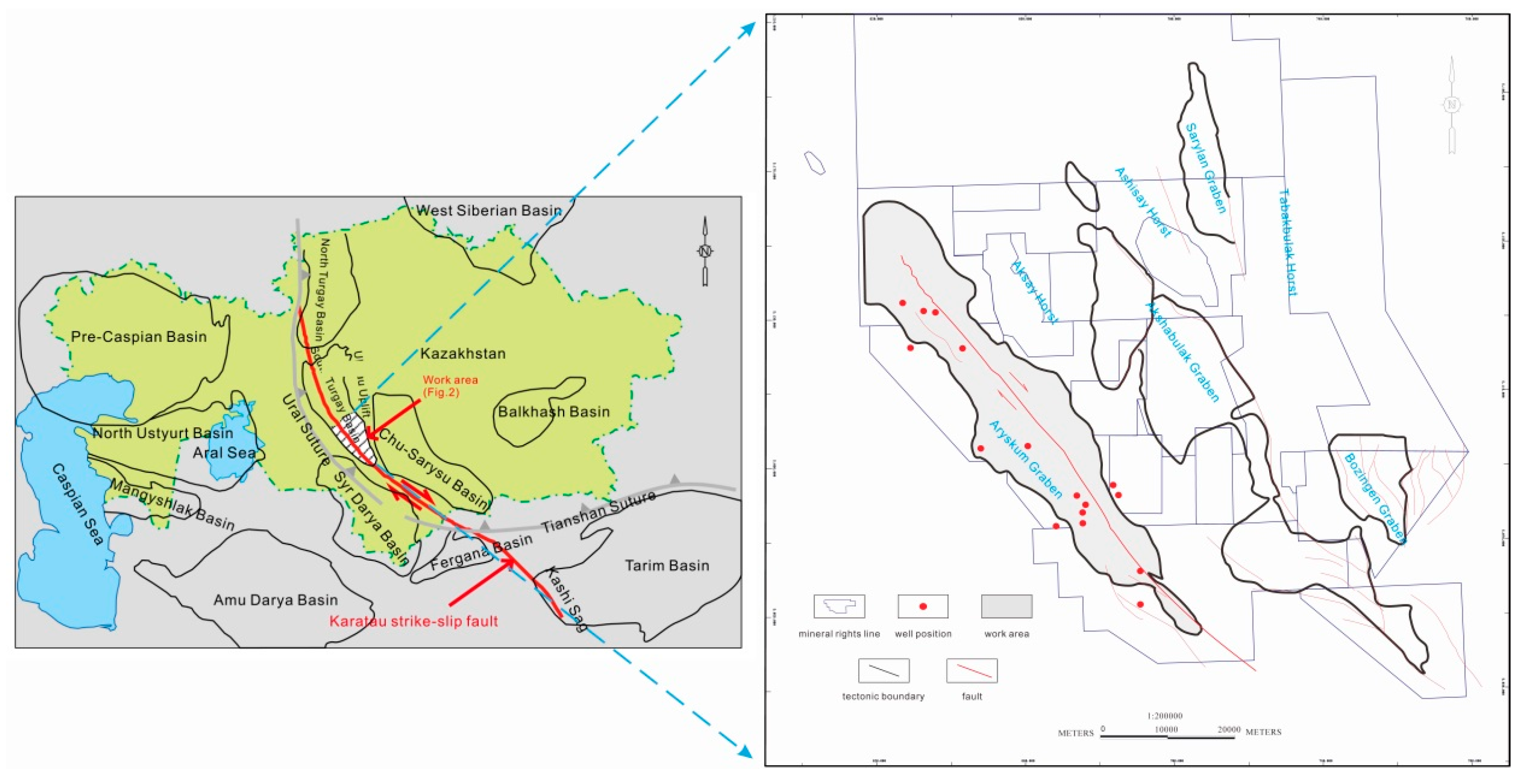

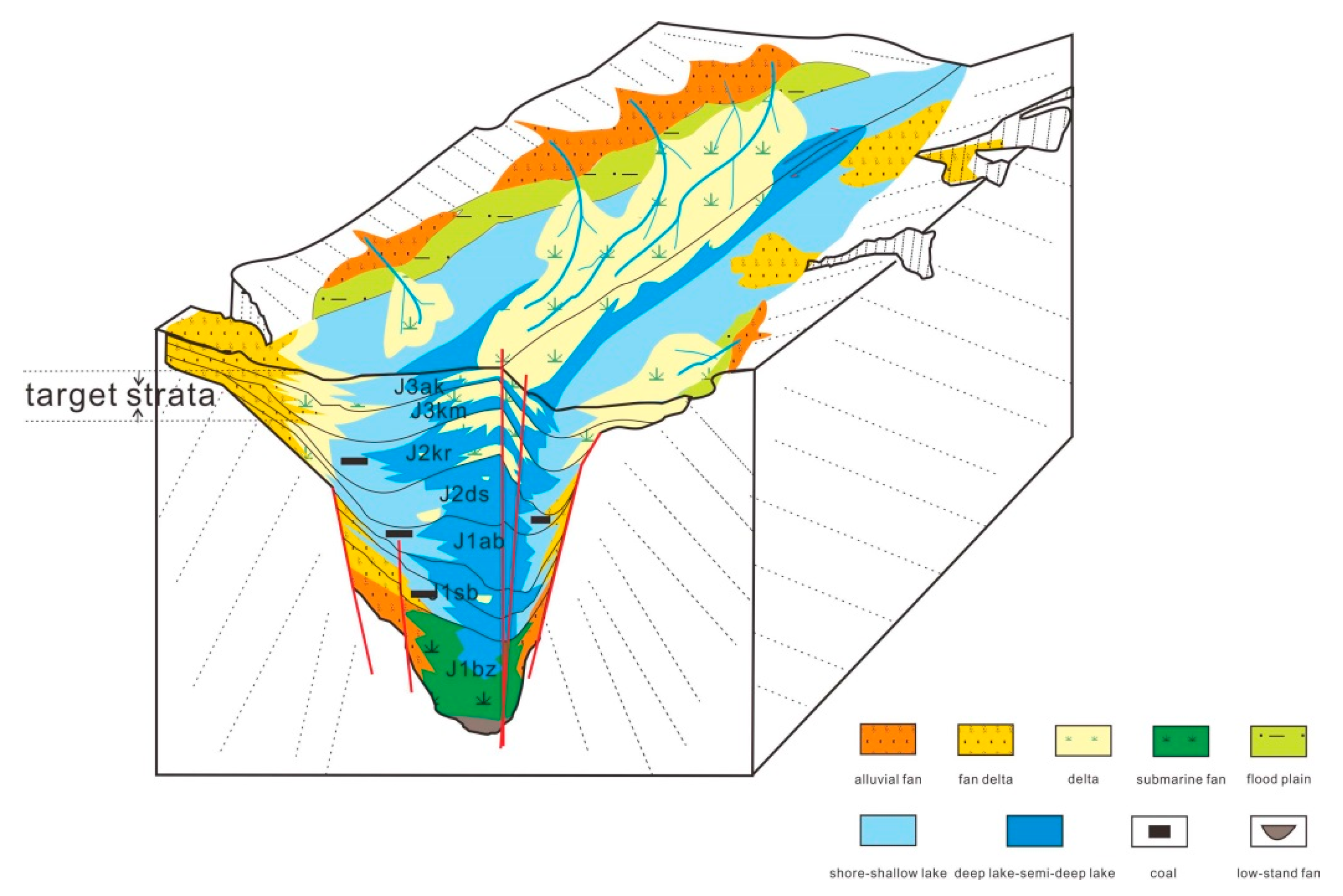
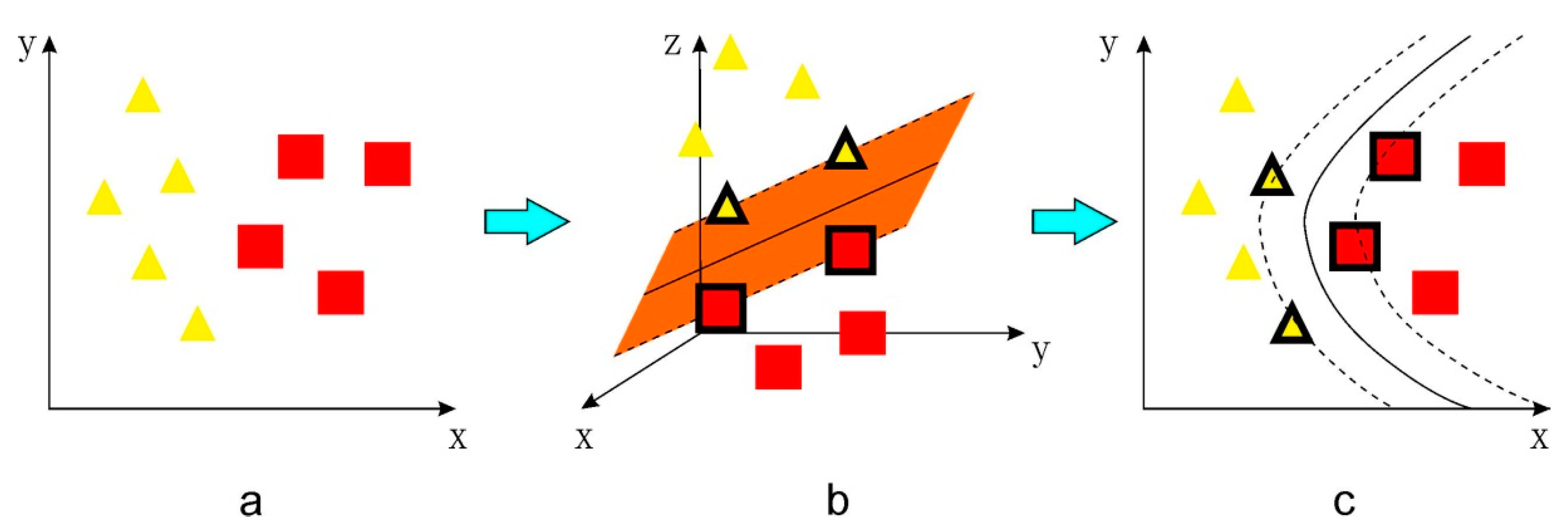

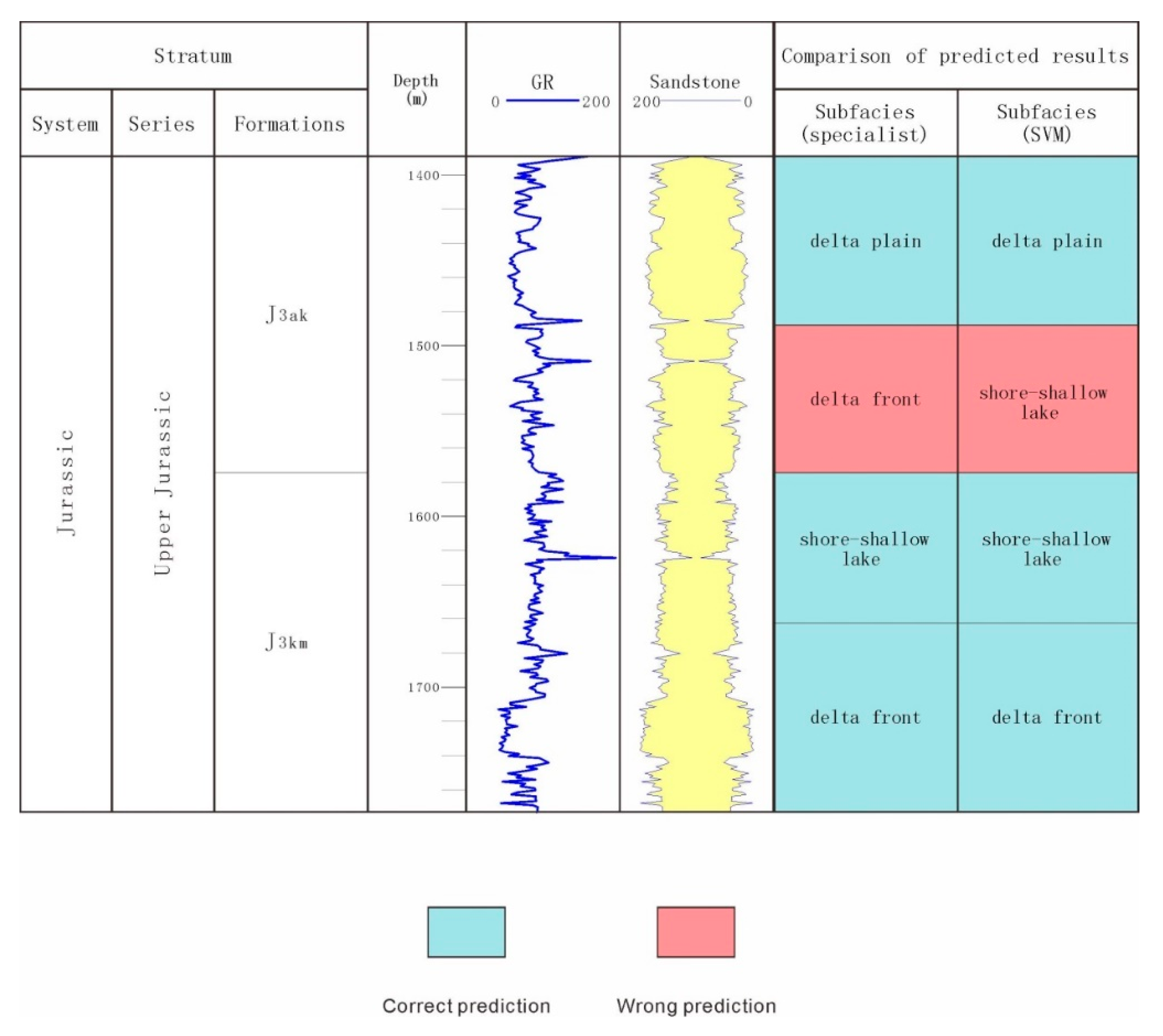
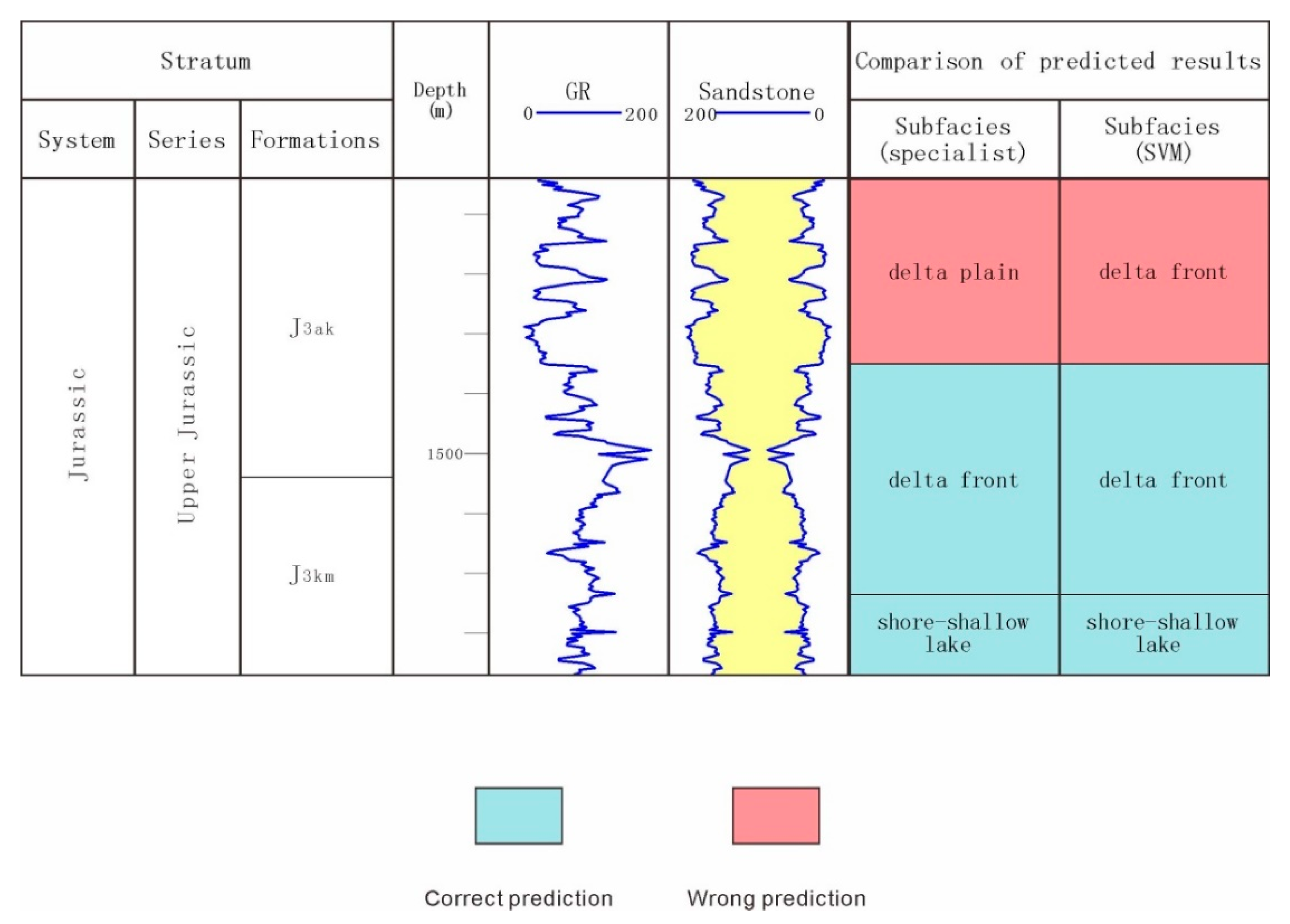
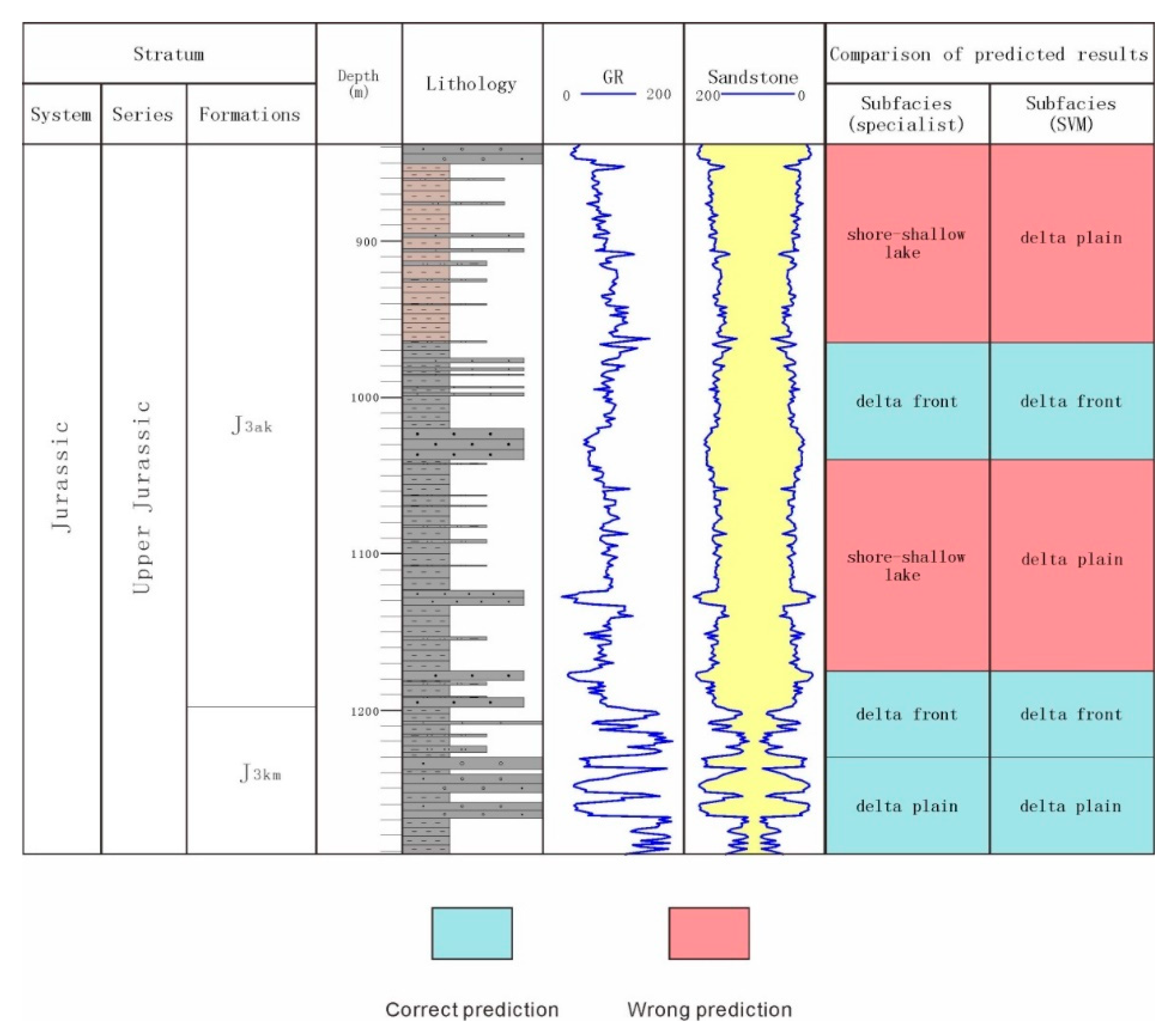
| Characteristics | G | S | Am | As-T | As-B | λL | λR | ||
|---|---|---|---|---|---|---|---|---|---|
| Subfacies | |||||||||
| Delta front | 0.51 | 13.78 | 105.09 | 53.72 | 17.20 | 0.31 | 1.10 | 2.81 | |
| Shore-shallow lake | 0.52 | 11.79 | 119.26 | 35.20 | 47.49 | 0.96 | 1.39 | 2.66 | |
| Delta front | 0.55 | 19.27 | 110.43 | 20.59 | 43.87 | 0.93 | 1.06 | 1.97 | |
| Delta plain | 0.47 | 32.33 | 109.83 | 83.92 | 114.18 | −0.23 | 0.77 | 2.70 | |
© 2019 by the authors. Licensee MDPI, Basel, Switzerland. This article is an open access article distributed under the terms and conditions of the Creative Commons Attribution (CC BY) license (http://creativecommons.org/licenses/by/4.0/).
Share and Cite
Ai, X.; Wang, H.; Sun, B. Automatic Identification of Sedimentary Facies Based on a Support Vector Machine in the Aryskum Graben, Kazakhstan. Appl. Sci. 2019, 9, 4489. https://doi.org/10.3390/app9214489
Ai X, Wang H, Sun B. Automatic Identification of Sedimentary Facies Based on a Support Vector Machine in the Aryskum Graben, Kazakhstan. Applied Sciences. 2019; 9(21):4489. https://doi.org/10.3390/app9214489
Chicago/Turabian StyleAi, Xiao, Hongyu Wang, and Baitao Sun. 2019. "Automatic Identification of Sedimentary Facies Based on a Support Vector Machine in the Aryskum Graben, Kazakhstan" Applied Sciences 9, no. 21: 4489. https://doi.org/10.3390/app9214489
APA StyleAi, X., Wang, H., & Sun, B. (2019). Automatic Identification of Sedimentary Facies Based on a Support Vector Machine in the Aryskum Graben, Kazakhstan. Applied Sciences, 9(21), 4489. https://doi.org/10.3390/app9214489




